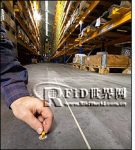
German forklift introduces RFID navigation efficiency to increase 30%
[ad_1]
Germany Jungheinrich Forklift Co., Ltd. is an industrial forklift and warehouse material circulation technology provider. The company now integrates RFID technology in their forklifts sold to North America to improve the efficiency of forklifts.
“Our purpose of using RFID is to maximize the use of forklifts,” explained Greg Mason, the general manager of Jungheinrich’s product and training. “How to make trucks carry more goods and work at the fastest speed is always our customers The problem.”

Jungheinrich embeds the label on the warehouse floor, making the EKX 513-515 rotary forklift more efficient
The EKX 513-515 rotary forklift is a long and narrow forklift, which is mainly used in the narrow aisles of warehouses or distribution centers; Jungheinrich has made some modifications to its existing design to be compatible with RFID readers and antennas. Cooperate. When the forklift moves in the warehouse, the reader collects the passive, 64 kHz or 128 kHz RFID tags embedded in the floor, and sends them to an on-board computer. The computer processes the tag data to control the operation of the forklift.
This RFID system can inform the forklift operating system of the forklift’s location and direction at any time. Jungheinrich embeds the first electronic tag on the floor at the entrance of each channel of the warehouse to identify the channel, and then embeds the second tag not far from the same channel.
If the reader continuously reads the first and second tags of the channel, the operating system defaults to the forklift entering the channel. When the forklift exits the channel, the reader reads the second and the first tag in sequence.

ModifiedEKX 513-515 rotary fork stacker
The label also stores other instructional codes, such as some warehouse aisle floors that are rough and uneven, which requires the forklift to not move forward at the fastest speed to ensure the safety of the operation. The tag embedded at the entrance of the channel is encoded with a code representing the speed of safe operation. When the forklift passes the tag, the reader sends the code to the operating system to command the forklift to slow down. If the forward speed of the forklift is already lower than the speed limit, the system will prevent the forward speed of the forklift in this passage from being higher than the speed limit.
Before automatically controlling the speed of the forklift, Mason explained that Jungheinrich customers had to set the speed of the forklift at a safe speed for rough floor operation, and the forward speed of the forklift throughout the warehouse must be maintained at this speed. Now through the use of RFID tags, the forklift can change the speed, only to slow down the speed in rough places, greatly improving the operating efficiency of the forklift.
The label can also contain other instructions, such as height restrictions. This is mainly because there may be permanent obstacles in the passage, such as low-altitude air conditioning and ventilation. If there is a transformation in the warehouse, the user can rewrite the label.
Jungheinrich is now selling this RFID platform on the EKX 513-515 forklift in North America. The improved RFID forklift is 30% more efficient than the original forklift.
[ad_2]



